 W
WAlejandro María Aguado y Remírez de Estenoz, 1st Marquess of Marismas del Guadalquivir, Spanish banker, was born of Old Christian parentage, originally from Sevilla, Andalusia, Spain.
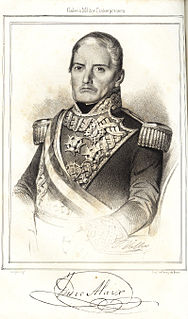 W
WIsidro de Alaix Fábregas, Count of Vergara and Viscount of Villarrobledo, was a Spanish general of the First Carlist War, supporting the cause of the Liberals, who backed Isabella II of Spain and her regent mother Maria Christina. Born at Ceuta, Alaix fought during the Spanish War of Independence and also participated in the campaigns in South America against the independence movements there.
 W
WCarlos María de Alvear, was an Argentine soldier and statesman, Supreme Director of the United Provinces of the Río de la Plata in 1815.
 W
WJuan Bautista Azopardo was a Maltese privateer and military man who fought under the flags of the Netherlands, Spain and Argentina.
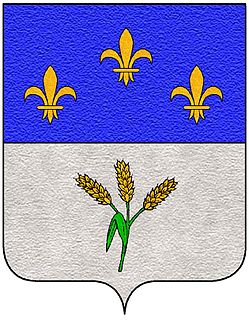 W
WJoseph Gregorio Belgrano (1762–1823) was an Argentine military officer and politician. His brother was the General Manuel Belgrano, member of the Primera Junta and hero in Argentine War of Independence.
 W
WMajor-General Patrick Campbell (1779–1857) was a Scottish army officer and diplomat born in Duntrune.
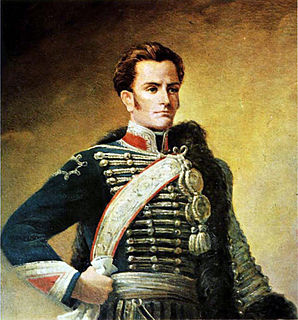 W
WJosé Miguel Carrera Verdugo was a Chilean general, formerly Spanish military, member of the prominent Carrera family, and considered one of the founders of independent Chile. Carrera was the most important leader of the Chilean War of Independence during the period of the Patria Vieja. After the Spanish "Reconquista de Chile" ("Reconquest"), he continued campaigning from exile after defeat. His opposition to the leaders of independent Argentina and Chile San Martin and O'Higgins respectively made him live in exile in Montevideo. From Montevideo Carrera traveled to Argentina where he joined the struggle against the unitarians. Carreras' small army was eventually left isolated in the Province of Buenos Aires from the other federalist forces. In this difficult situation Carrera decided to cross to native-controlled lands all the way to Chile to once for all overthrow Chilean Supreme Director O'Higgins. His passage to Chile, which was his ultimate goal, was opposed by Argentine politicians and he engaged together with indigenous tribes, among the Ranquels, in a campaign against the southern provinces of Argentina. After the downfall of Carreras' ally, the Republic of Entre Ríos, and several victories against the United Provinces of the Río de la Plata Carrera's men were finally defeated by numerically superior forces near Mendoza. Carrera was then betrayed by one of his Argentine helpers, leading to his capture and execution in that city. José Miguel Carrera was of Basque descent.
 W
WCosme Damián de Churruca y Elorza was a Basque Spanish noble, an Admiral of the Royal Spanish Armada, scientist and Mayor of Mutriku, who died at the Battle of Trafalgar while commanding the ship of the line San Juan Nepomuceno.
 W
WJosé María Fernández de Córdoba y Rojas, was a Spanish military who played an important role in the early stages of the Argentine War of Independence.
 W
WRoger-Bernard-Charles Espagnac de Ramefort, better known as Charles d'Espagnac or, from 1817, Carlos d'Espagne, was a French-born Spanish general who saw distinguished service in the Peninsular War, but as governor of Barcelona, was a cruel, despotic and much-hated persecutor of Spanish liberals. In his letters and dispatches, Wellington refers to him as Carlos de España.
 W
WBaldomero Fernández-Espartero y Álvarez de Toro was a Spanish marshal and statesman. He served as the Regent of the Realm as well as three times as Prime Minister. Throughout his life, he was endowed with a long list of titles such as Prince of Vergara, Duke of la Victoria, Count of Luchana, Viscount of Banderas and was also styled as "the Peacemaker".
 W
WValentín Ferraz y Barrau was a Spanish military commander and politician. After fighting in the Peninsular War and in the Peruvian War of Independence Valentín engaged in the chaotic politics of the post-war reign of Isabella II of Spain, serving as Prime Minister of Spain in 1840 and holding other important offices such as Mayor of Madrid.
 W
WJuana Galán (1787–1812), nicknamed La Galana, was a guerrilla fighter of the Peninsular War (1808–1814) who took to the street to fight against the French cavalry that tried to pass through the town of Valdepeñas. At twenty years old, she was considered the best informed woman of the village, because she worked in a strategic location, the first tavern in the village.
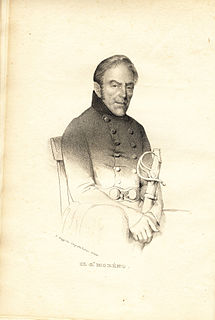 W
WVicente González Moreno was a Spanish general who supported the Carlists during the First Carlist War. He was appointed commander of Carlist forces after the death of Zumalacárregui.
 W
WJosé Manuel de Goyeneche y Barreda, 1st Count of Guaqui was a Spanish soldier and diplomat.
 W
WRafael Maroto Yserns was a Spanish general, known both for his involvement on the Spanish side in the wars of independence in South America and on the Carlist side in the First Carlist War.
 W
WJuan de O'Donojú y O'Ryan was a Spanish military officer and "Jefe Político Superior" ("viceroy") of New Spain from 21 July 1821 to 28 September 1821 during the Mexican War of Independence. He was the last Spanish viceroy of New Spain.
 W
WMarcelino de Oraá Lecumberri (1788–1851) was a Spanish military man and administrator. Born in Beriáin in Navarre, he distinguished himself as a cadet during the War of Spanish Independence. He was married to Josefa de Erice, later Condesa de Chiva y Vizcondesa de Oráa.
 W
WMariano de Osorio was a Spanish general and Governor of Chile, from 1814 to 1815.
 W
WMelitón Pérez del Camino (1772–1845) was a squad leader of the Royal Spanish Navy.
 W
WRafael del Riego y Flórez was a Spanish general and liberal politician, who played a key role in the outbreak of the Liberal Triennium.
 W
WJacinto de Romarate Salamanca was a Spanish sailor, who fought in the British invasions of the Río de la Plata and on the Royalist side during the Argentine War of Independence. Back in Spain, he participated in the First Carlist War.
 W
WJosé Francisco de San Martín y Matorras, known simply as José de San Martín or the Liberator of Argentina, Chile and Peru, was an Argentine general and the primary leader of the southern and central parts of South America's successful struggle for independence from the Spanish Empire who served as the Protector of Peru. Born in Yapeyú, Corrientes, in modern-day Argentina, he left the Viceroyalty of the Río de la Plata at the early age of seven to study in Málaga, Spain.
 W
WMiguel de la Torre y Pando, conde de Torrepando was a Spanish General, Governor and Captain General, who served in Spain, Venezuela, Colombia and Puerto Rico during the Spanish American wars of independence and afterwards.
 W
WJose Maria Torrijos y Uriarte, Count of Torrijos, a title granted posthumously by the Queen Governor, also known as General Torrijos, was a Spanish Liberal soldier. He fought in the Spanish War of Independence and after the restoration of absolutism by Ferdinand VII in 1814 he participated in the pronouncement of John Van Halen of 1817 that sought to restore the Constitution of 1812, for which he spent two years in prison until he was released after the triumph of the Riego uprising in 1820. He returned to fight the French when the Hundred Thousand Sons of Saint Louis invaded Spain to restore the absolute power of Ferdinand VII and when those triumphed ending the liberal triennium exiled to England. There he prepared a statement which he himself led, landing on the coast of Málaga from Gibraltar on December 2, 1831, with sixty men accompanying him, but they fell into the trap that had been laid before him by the absolutist authorities and were arrested. Nine days later, on December 11, Torrijos and 48 of his fellow survivors were shot without trial on the beach of San Andres de Málaga, a fact that was immortalized by a sonnet of José de Espronceda entitled To the death of Torrijos and his Companions, Enrique Gil y Carrasco's A la memoria del General Torrijos, and by a famous painting that was painted in 1888 by Antonio Gisbert. "The tragic outcome of his life explains what has happened to history, in all fairness, as a great symbol of the struggle against despotism and tyranny, with the traits of epic nobility and serenity typical of the romantic hero, eternalized in the famous painting by Antonio Gisbert." The city of Málaga erected a monument to Torrijos and his companions in the Plaza de la Merced, next to the birthplace of the painter Pablo Picasso. Under the monument to Torrijos in the middle of the square are the tombs of 48 of the 49 men shot; One of them, British, was buried in the English cemetery (Málaga).
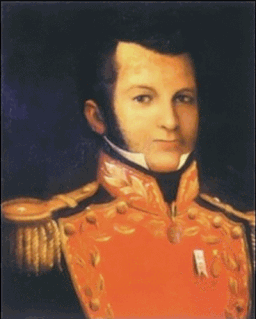 W
WAntonio Valero de Bernabé Pacheco, a.k.a. The Liberator from Puerto Rico, was a Puerto Rican military leader. Trained in Spain, he fought with the Spanish Army to expel the French leader, Napoleon Bonaparte, from Spain and was promoted to colonel during these years.
 W
WJuan Van Halen y Sarti was a Spanish military officer. After fighting for the losing side in the Peninsular War, he was forced to flee to Spain. Van Halen became a military adventurer throughout Europe and went on an 18-month tenure as a colonel in the Russian Caucasus Dragoon Regiment until his removal by Tsar Alexander I of Russia.
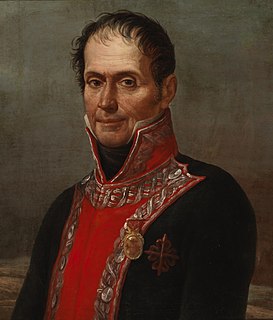 W
WFrancisco Javier Venegas de Saavedra y Ramínez de Arenzana, 1st Marquess of Reunión and New Spain, KOC was a Spanish general in the Spanish War of Independence and later viceroy of New Spain from September 14, 1810 to March 4, 1813, during the first phase of the Mexican War of Independence.
 W
WTomás de Zumalacárregui e Imaz, known among his troops as "Uncle Tomás", was a Spanish Basque officer who lead the Carlist faction as Captain general of the Army during the First Carlist War. He was occasionally nicknamed the "Wolf of the Amezcoas", making reference to his famous military victory in the region of Navarre.
 W
WMartín Zurbano Baras was a Spanish military figure. A guerrilla leader, he is considered a "martyr to Spanish liberty".